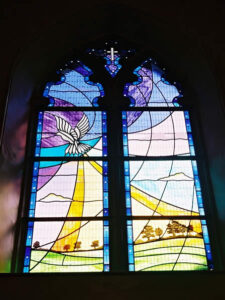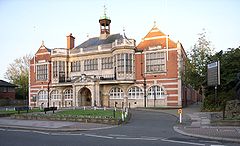
Trident “Papa-India” Memorial Window, St Mary’s Church, Staines.
Image source: artemis glass
Shortly after take-off on the afternoon of Sunday 18 June, 1972, British European Airways Flight 548, a Hawker Siddeley Trident passenger aircraft with the call sign Papa India, crashed near Staines, Surrey, England, en route from Heathrow to Brussels. All 118 people on board were killed.
Among the victims were a number of Homeopaths and homeopathic supporters bound for the International Homoeopathic League Congress in Brussels. These included Isabel Campbell, Dudley Wooton Everitt and his wife, Marjory (Margot), Marjorie Golomb Feigenbaum, Elizabeth Sharp Hawthorn, Sergei William Kadleigh, sisters Kay (Kawther) Theresa Kandalla and Ludi Marylone Kandalla, Joan Mackover, John Robertson Raeside, Mary Stevenson, Elizabeth Somerville Stewart and Thomas Fergus Stewart, who all died in that fatal crash.
Two benches in Queen Square are dedicated to the memory of the sixteen Homeopaths who were killed in the tragedy.
As a permanent memorial to the 118 people who lost their lives in the disaster, in 2004 a stained glass window was installed in the parish church of St Mary’s in Staines, accompanied by a Memorial Book sponsored by British Airways. A memorial garden was also opened at Moormead Sports Ground off of Waters Drive, Staines, close to the site of the crash.
On 18 June 2012 a service of remembrance was held at St George’s Church, Queen Square opposite the hospital; in this same church there had been a service 40 years before. The service was conducted by Rev. Jeremy Swayne, himself a retired homeopathic physician. Taking part were Dr Peter Fisher – Clinical Director of the RLHIM; Richard Murley, Chair of the UCLH NWS Foundation Trust; Enid Segall, former Secretary of the British Homeopathic Association; Professor Lord Robert Winston – whose mother-in-law was on the plane; Francis Treuherz, Hon Secretary of the Society of Homeopaths and Dr Sara Eames, President of the Faculty of Homeopathy. Dr Helmut Roniger played a musical interlude on the piano.
The hard work of arranging the event was mainly undertaken by Sato Liu, of the Friends of the RLHIM. She managed to attract some 120 people, many of whom were descendants and families and friends of those who lost their lives in the ‘Papa India’ crash at Staines 40 years ago. Enid Segall remarked that while everyone remembers where they were when the news of the assassination of President Kennedy reached them, she vividly recalled hearing of the crash – having worked at Nelsons for 9 years, she knew so many of the deceased. Sara Eames recalled that she had been a teenager and could not then conceive of a British Airways plane crashing. My wife told me that learning of the crash was the first time she heard the word homeopathy.
Present also were many members of the homeopathic profession, current and retired, students and patients. It was a poignant occasion, one for people of all faiths and none. Lord Winston read Psalms 23 and 121. Francis Treuherz read a message of condolence from the Chief Rabbi, Lord Sacks. Tariq Khan, Podiatrist at the RLHIM had arranged for two screens to display photographs and memoirs of the deceased in a rolling display before and after the service. The congregation gathered for refreshment, and caught up with old times. An invitation was extended to tour the hospital. Flowers had been laid on the two benches in Queen Square, commemorating those who had perished. It was an event full of poignancy, yet very positive in reinforcing that our mission to heal according to the principles of Hahnemann must continue. [Francis Treuherz]
On Saturday 18 June, 2022, a memorial service was held at St Mary’s Church in Staines to commemorate the 50th anniversary of the tragedy.
From the British Homeopathic Journal 61.3 (July 1972)
It is with deep regret that we make the following announcement. On Sunday, 18 June 1972, a number of members and friends of the Faculty of Homoeopathy, and relatives travelling with them, lost their lives in an air crash as they were on their way to the International Homoeopathic League Congress at Brussels:
Frederick W. Adams, B.Sc., F.P.S., F.R.I.C., former Secretary and Registrar of the Pharmaceutical Society of Great Britain.
Margaret Adams, his wife.
Isabel Mackay Campbell, M.B., Ch.B.Glas., M.F.Hom., Regional Representative for Scotland.
Dudley Wootton Everitt, M.P.S., Honorary Associate Member of the Faculty.
Margot Everitt, his wife.
Marjorie Golomb Feigenbaum, M.B., B.S.Lond., M.R.C.S.Eng., L.R.C.P.Lond., M.F.Hom.
Miss Elizabeth Sharp Hawthorn, R.G.N., S.C.M., M.T.D., Nursing Administration Certificate (Hospital) Edinburgh, Matron of the Glasgow Homeopathic Hospital.
Sergei William Kadleigh, M.B., B.S., M.R.C.S., L.R.C.P., Associate Member of the Faculty.
Ludi Marylone Kandalla, M.B., Ch.B., L.M.S.S.A., M.F.Hom.
Kay (Kawther) Teresa Kandalla, M.R.C.S., L.R.C.P.
Joan Natalie Mackover, M.R.C.S.Eng., L.R.C.P.Lond., D.P.H.Eng., Associate Member of the Faculty.
John Robertson Raeside, M.B., Ch.B.Glas., M.F.Hom.
Mary Young McArthur Stevenson, M.B., Ch.B.Glas., D.P.H.Camb., M.F.Hom.
Elizabeth Somerville Stewart, M.B., Ch.B.Glas., Associate Member of the Faculty.
Thomas Fergus Stewart, T.D., M.B., ChB.Glas., M.R.C.P.Glas., F.F.Hom.
The Guardian report of the Staines Air Disaster, by Peter Harvey, Monday 19 June, 1972.
There were no survivors when the plane crashed, less than four minutes after taking off for Brussels. Its wheels had been retracted and the plane was climbing when it suddenly dropped, skimming over high-tension power lines and across the tops of cars before crashing on its underside.
The impact broke the plane’s spine, ripping off the tail section and sending it spinning through the air. The fuselage slewed across the muddy field and hit a line of trees on the edge of a reservoir.
The plane had hit an incredibly small space – a field no more than 100 yards wide. The way in which it crashed suggested that it might have lost virtually all power; it came almost straight down, missing houses on either side of the field.
A stall, from which the pilot would need a lot of height to recover even if it were not of the dangerous “deep” variety, would have the same effect….
Thirty four Britons were killed in the crash, including the crew. There were 29 passengers from the United States, 29 Belgians, 12 Irish, four South African, three Canadian, one Thai, two Jamaicans, one Latin American, one Indian, one French Afrique, and one Nigerian. There were between 25 and 30 women passengers, as well as two or three children.
The Department of Trade and Industry said the pilot’s last message to ground control came two minutes after take-off. It said “Up to 60? which the DTI said, “Is quite a normal message.” It means the pilot was climbing to a level of 6,000 feet.”
After the crash, wreckage was scattered for a radius if almost four hundred yards around the shattered fuselage. The hundreds of workers struggling in clinging mud and a steady drizzle to cut their way into the buckled remains of the plane were hampered through the night by hundreds of sight-seers flocking towards the area.
Mr. Cranley Onslow, Parliamentary Under Secretary for Aerospace, who went to the scene, said “callous” sight-seers were hampering the rescue workers. Two hours after the crash, all roads in the area were jammed by traffic.
The Trident, on flight BE 548 and code named G-ARPI, left Heathrow at 5.02pm with 109 passengers and nine crew members. By 5.06pm, it had crashed.
A man who had been driving along the A30 told police: “The plane just came whizzing in, along the road. You could have reached up and touched it.”
Heathrow aircraft control sounded the full scale disaster alert, and all airport emergency appliances, together with all available fire engines, ambulances, and police patrol cars for eight miles around sped to the scene. Nine hospitals in the area prepared to receive casualties, and doctors were brought in for emergency duty. In the event, they were not needed.
As the first teams of firemen reached the wreck site – throughout the night they were to work at considerable personal risk as the aircraft contained tones of highly flammable fuel – they clawed with their hands in desperate attempts to reach the passengers inside. A local doctor who ran to the spot said: “It was ghastly, sickening. A terrible mess.”
As police blocked off surrounding roads, other rescue teams began knocking down fences to enable ambulances to reach the plane. By 7pm, 70 bodies had been lifted from the fuselage and laid in long rows along the ground.
Long lines of rescuers formed in the steady drizzle, passing the broken bodies of the victims gently from the shattered fuselage to the ambulances. A number of the rescuers, police and firemen, were crying. One policeman said a small girl died in his arms as he carried her towards an ambulance.
One man was taken out of the wreckage with head injuries but died in hospital. He is understood to be Mr Melville Miller, managing director of Rowntree Mackintosh (Ireland) Limited.
A mobile crane was brought into the field to lift parts of the wreckage away; the rescuers could not use oxyacetylene cutters because of the risk of an explosion. Relays of ambulances began taking the bodies to the special mortuary.
Mr Michael Stephens, of Staines, said he was cycling along a road near by “When I looked up and saw the tail of a plane bounce into the air … then the rest of the plane burst into flames.” The fire was an isolated electrical fault and was quickly put out.
Miss Christine Wallis said she was walking past the reservoir with friends when “bits of metal began flying around us … the plane split up as it tore along the ground.”
Last night teams of investigators from the Department of Trade and Industry and the British Airline Pilots’ Association arrived at the scene to find out the contents of the flight recorders.
The same plane was involved in a collision in July 1968, at Heathrow. It was stationary at one of the terminal piers when a freighter jet carrying horses got out of control and crashed into its side. Five people were killed in the freighter. The Trident’s tail was torn off.
Without a cockpit voice recorder (CVR), which were not required in Britain at the time, we will never know for sure. The Air Accidents Investigation Board (AAIB) concluded that Second Officer Keighley was too inexperienced and that Ticehurst was preoccupied with the passenger in the cockpit (another BEA captain on a return flight).
Two seconds after the droops were retracted, the stick pusher stall recovery device operated, causing the autopilot to automatically disengage and the nose of the aircraft to pitch down. At that moment, the stall recovery system was manually inhibited by one of the pilots.
The aircraft then pitched up rapidly, losing speed and height, entering a true aerodynamic stall and then a deep stall from which no recovery was possible. Impact occurred 20 seconds later. An autopsy on the captain suggested that he had probably had a heart attack during the short flight.



Leave A Comment